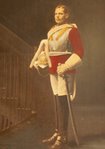
William Dey Smedmore, my grandfather, married Amanda Brown in the Kingston Parish Church on December 6, 1882. The groom gave his age as forty-four, and the bride gave hers as twenty-one. (My mother always said that her mother was eighteen when she got married to a man old enough to be her father.) My grandfather gave his father's name as William Dey Smedmore, deceased, and my grandmother's father's name was given as Daniel D. Brown, or so it appears on the marriage record.

Of course, this marriage record is something I discovered later, after I had begun serious research into the family. Before this I asked questions of the family, and in fact, it was my uncle, Rodney Smedmore, who told me that Amanda's father's name was Daniel Elias Brown and that he had married a Mrs. Williamson. Well, he had Daniel`s name right, but Daniel didn't marry a Miss or Mrs. Williamson, as I later discovered. In fact all that I knew at that time about the Browns was that my grandmother, Amanda, had three sisters named Susan, Bertha and Theresa. Susan had married John Cassis and my mother kept in touch with their son, also named John who lived with his wife, Fanny, in Toronto. There was also another son named Cromwell Cassis, but I knew very little about him. My great-aunt Bertha had married Percy Esterine and they lived in New York, and each Christmas Aunt Bertha would send us a lovely box of Whitman's Sampler chocolates. As for Theresa, she was the only one, beside my grandmother, that I actually knew as she lived with my family for a while, and I called her Aunt Tess. Everything else I found out about the family was through my research, using the records which had been microfilmed in Jamaica by the Church of Jesus Christ of Latter-day Saints, known as the Mormons.
It was through these records that I discovered that Daniel Elias Brown was born in Kingston, in 1827, to Edward and Sarah Brown. His baptismal record says that he was coloured and born at King Street, Kingston, 25 February 1827, and baptized May 3 of that year.

This is a photo of King Street taken by the French photographer, Adolphe Duperly.
Daniel had siblings, a sister, Susan Saunders Brown (more of her later) and another sister, Eliza, and a brother, Jonas. Interestingly enough, Daniel gave his eldest child, Susan, the middle name Saunders, so it may have been his mother's maiden name ... something I haven't so far been able to confirm.
Daniel went to Port Royal at some point where he was employed in the dockyard as a shipwright, and where he married in 1858 Sarah Letitia McDonald, formerly Huggins. Sarah was a widow. Her first husband had been a shoemaker named Donald McDonald, by whom she had two daughters, Elizabeth Huggins McDonald and Mary Noel McDonald. I have followed the family of Elizabeth McDonald, but know nothing more about Mary. I do, however, know something of the life of Sarah Letitia Huggins.
Sarah`s father was one James Vashon Huggins, born in 1803 in Port Royal, the illegitimate son of a Lieutenant Huggins and Sarah Vashon, who was born about 1775. I have not so far found her baptismal record. I do know that she was a free quadroon woman and had another son for one Leonard Procter of His Majesty`s Navy. This child, Robert Vashon Mitchell Procter, was baptized in Port Royal in 1798. According to the 1824 Almanac for Port Royal, Sarah Vashon owned four slaves, so was probably fairly well off. It is noted in the Manumission of Slaves for 1822 that she freed one of them, a Susannah Smith.
The Port Royal Copy Register of Baptisms, Marriages and Burials is missing many records. I did find a marriage for James Vashon Huggins to a Mary Goldson in 1830, by which there were two children, Elizabeth, born in 1831, and Sarah Letitia, born in 1832. Sarah married Donald McDonald in 1851. Their eldest child was born about 1852, and their other daugher, Mary, was born in 1854. Donald must have died before 1858 (though I have not found a burial record for him) as Sarah Letitia was married as a widow that year to Daniel. Although both Daniel and Sarah had been baptized in the Church of England they were married in Port Royal in the Methodist faith, and their children were all baptized in the Methodist church. It was not until I was able to hire a researcher in Jamaica to find the records (which were in the Archives at Spanish Town) that I was able to flesh out the Brown family ... but more of that in another post.










 A View of Upper King Street, Kingston
A View of Upper King Street, Kingston


 This is a photo of King Street taken by the French photographer, Adolphe Duperly.
This is a photo of King Street taken by the French photographer, Adolphe Duperly.
